In this emerging world of modern design of structures, Concrete acts as the backbone of civil engineering. A structural engineer’s first and foremost objective is to build an efficient and durable concrete structure that is also aesthetically pleasing. Here comes the role of a concrete designer. When the aim is to build a concrete structure that is efficient and durable, this demands to follow the concrete mix design steps as per IS codes (IS- 10262:2009 and IS- 456:2000).
If you are searching for detailed step by step procedure for concrete mix design of M50 grade using IS – 10262:2009 and IS – 456:2000…. Then yes you are in the write place!!!
Before reading this post just go and check “Concrete mix design procedure as per IS 10262:2009 & IS 456:2000” .
This post will help you to have a brief idea of different parameters required and will also make you aware about the different experimental data required for conducting the mix design of concrete.
Concrete Mix Design
- Calculate cement, sand and aggregate quantity in concrete.
- Calculate the number of premix bags required for your project.
- Option to set your own size and rate of premix bags.
- Calculate the volume of concrete required for slabs, walls, footings and columns.
- Calculate the weight of ingredients required for preparing the calculated volume of concrete.
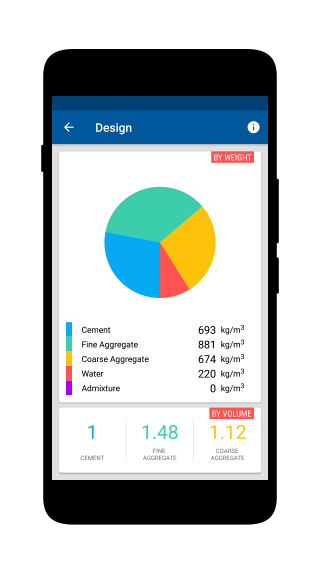
Detailed calculation for M50 Grade mix
The different design stipulations required for the desired mix are shown in the table below:
| Stipulations for proportioning | |
|---|---|
| Type of Concrete | RCC |
| Grade Designation | M50 |
| Shape of Particle | Angular |
| Slump | 50 mm |
| Water- Cement Ratio | 0.45 |
| Exposure Condition | Severe |
| Concrete Placement | Pump |
| Degree of Supervision | Good |
The different experiemental data required for the desiered mix are shown in the table below:
| Sieve analysis | |
|---|---|
| Fine Aggregate | Zone 1 |
| Coarse Aggregate | 20 mm |
| Chemical Admixture | |
|---|---|
| Volume ( By mass of cement) | 2% |
| Water Content Reduction | Zero |
| Test data for materials | |
|---|---|
| Standard Deviation | 5 MPa |
| Specific Gravity of Fine Aggregate | 2.74 |
| Specific Gravity of Coarse Aggregate | 2.74 |
| Specific Gravity of Cement | 3.15 |
| Specific Gravity of Admixture | 1.145 |
| Water absorption of Fine Aggregate | 1.0 % |
| Water absorption of Coarse Aggregate | 0.5% |
| Free Surface Moisture of Fine Aggregate | Zero |
| Free Surface Moisture of Coarse Aggregate | Zero |
Step by step detailed procedure for concrete mix design of M50 grade as per IS – 10262:2009 and IS- 456:2000
Step 1: Calculate the target mean compressive strength at 28 days
| target mean compressive strength | characteristic strength + 1.65 X Standard Deviation |
| target mean compressive strength | 50 + 1.65 X 5 = 58.25 N/mm2 |
Where sufficient test results for a particular grade of concrete are not available, the value of standard deviation could be taken from Table 1 of IS-10262.
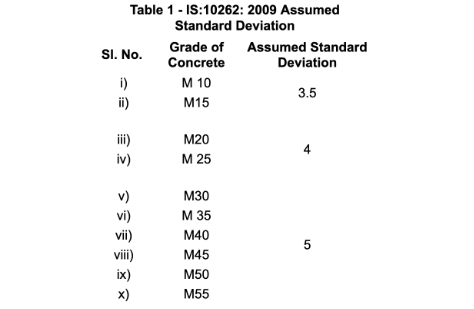
Step 2: Selection of maximum water/cement ratio
The maximum water-cement ratio should be selected as per Table 5 of IS – 456: 2000.
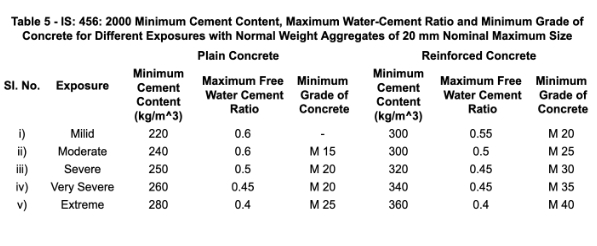
| Maximum water-cement ratio | 0.45 |
| Adopted water-cement ratio | 0.45 |
Step 3: Estimation of entrapped air
For the maximum size of aggregate used the air content is estimated.
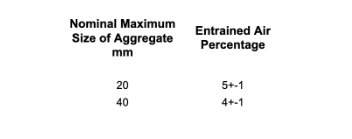
Step 4: Selection of water content and fine to total aggregate ratio
The selection of water content is based on Table 2 of IS:10262:2009.
Maximum water content for 20 mm aggregate and a slump value of 25 to 50 mm = 186.00 l.
| Estimated water content | 186 litres |
Step 5: Calculation of Cement content
The cement content per unit volume of concrete is computed sing Table 5 of IS:456:2000:
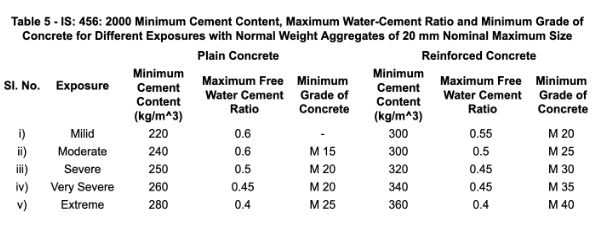
| Minimum cement content for severe expossure condition | 320 kg/ m3 |
| cement content | 186/0.45 = 413.33 kg / m3 |
Step 6: Calculation of aggregate content
Volume of coarse aggregate per unit volume of total aggregate for corresponding to 20 mm maximum size and zone 1 of fine aggregate = 0.60 – Table 3 of IS- 10262:2009.
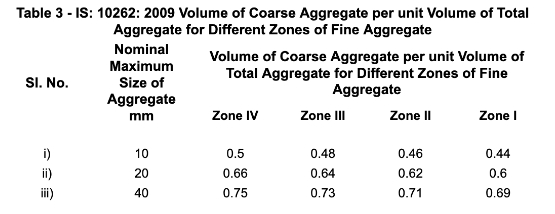
Correction:
| Based on water cement ratio | 0.01 |
| Based on placement | 10.00 |
Hence Volume
| Coarse aggregate | 0.55 |
| Fine aggregate | 0.45 |
$$
V=\left[W+\left(C / S_{c}\right)+(1 / P) \cdot\left(f_{a} / S_{f a}\right)\right] \times(1 / 1000)
$$
$$
C_{a}=1- P / P \times f_{a} \times S_{ca}/ S_{fa}
$$
| Mass of Coarse aggregate | 1027.08 kg / m3 |
| Mass of Fine aggregate | 843.74 kg / m3 |
Step 7: Computation of actual quantities required for a concrete mix – Trial mix
Water Correction
Extra quantity of water to be added
| Coarse aggregate | 5.14 kg |
| Fine aggregate | 8.44 kg |
| Mix Design | |
| Cement | 413 kg / m3 |
| Water | 200 kg / m3 |
| Fine Aggregate | 835 kg / m3 |
| Coarse Aggregate | 1022 kg / m3 |

Mix design Result
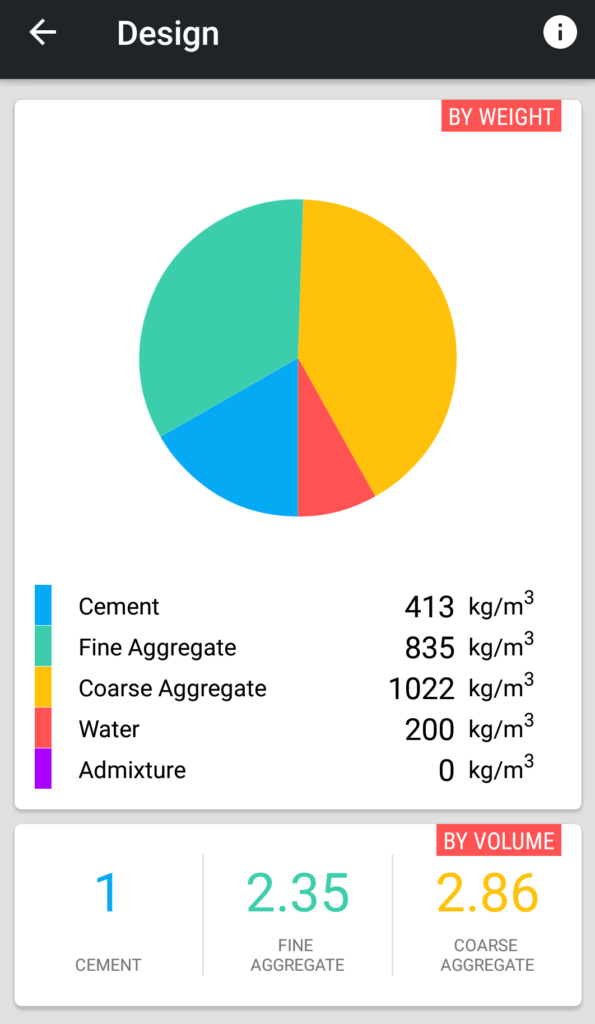
In order to check the efficiency of the designed concrete mix we shall prepare different trial mixes and the same are tested to check the strength and workability of designed concrete mix. If the designed concrete mix fails to meet the desired properties then minor adjustment is done in the water cement ratio and aggregate quantities, then again the trial mixes are prepared.
Hope this post helped you to learn the step by step procedure for concrete mix design using IS code ( IS – 10262: 2009 and IS – 456: 2000)
As per the table No. 5 IS 456-2000 the Max grade of Concrete is M40 and Max water-cement ratio is 0.4 , Where as you have take water -cement ratio 0.45 for M30.
Is it when the grade of concrete increased with decreased water-cement ratio or what is the max. water ratio and water content for the M50 and above grade . Can we take max. water content for normal aggregate size 20mm will 186kg/Cm for 25-50 mm slump?
The water cement ratio given in table 5 of IS 456 : 2000, is depending on the exposure condition.
For example:
When the exposure condition is severe, you have to select water cement ratio less than or equal to 0.45, and the minimum grade of concrete which should be used is M30.
In practical situations it is always better to go for a slightly higher grade of concrete under this type of exposure condition.
To know more about the detailed step by step procedure just check out this video “https://www.youtube.com/watch?v=O_SdmiY1F1A” .
Would love to help you if any query is still left. Stay connected.
Sir,
Thank you for your advice
Incorrect water cement ratio taken. To get target strength water cement ratio must be selected from curves in IS 10262-2019. Table 5 of is 456 gives minimum criteria for a given exposure condition.
Very nice